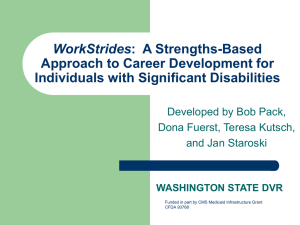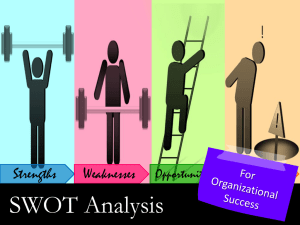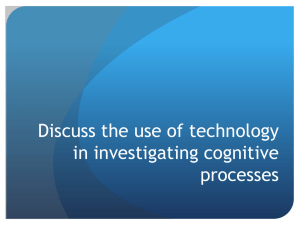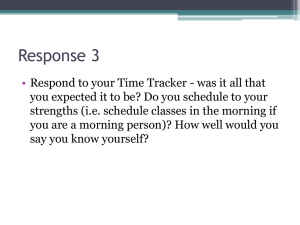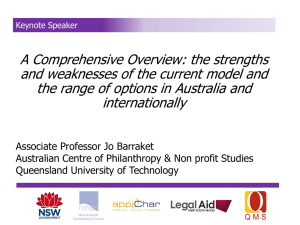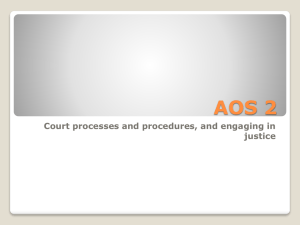Strengths model approach
advertisement
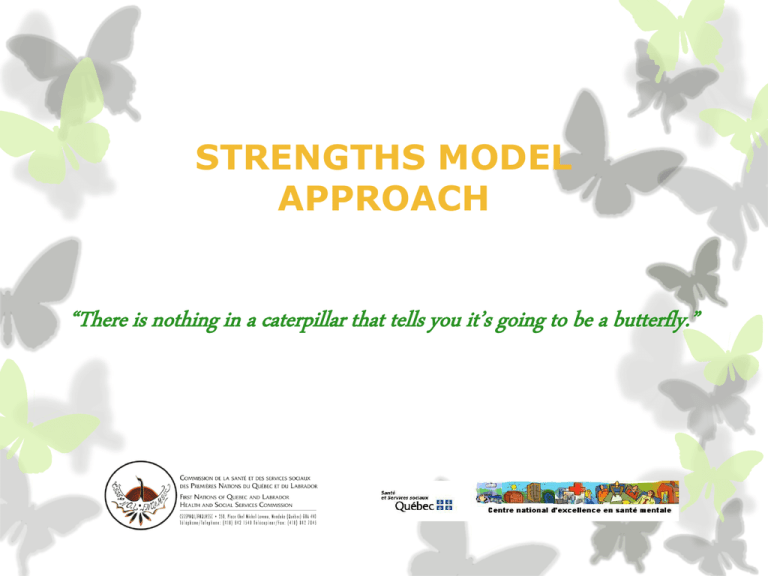
STRENGTHS MODEL APPROACH “There is nothing in a caterpillar that tells you it’s going to be a butterfly.” STRENGTHS MODEL APPROACH OBJECTIVES OF THE WORKSHOP General objective: • Explaining the strength-based approach • Providing the participants with tools Specific objectives: At the end of this workshop, you will be able to: • Describe the philosophy, principles and components of the approach • Recognise and identify a person’s strengths • Determine if you would like to learn more about this approach STRENGTHS MODEL APPROACH WORKSHOP OUTLINE 1. Philosophy and principles 2. Areas of life and strengths 3. The strength-based assessment and the recovery plan STRENGTHS MODEL APPROACH STRENGTHS-BASED APPROACH • Developed by Charles Rapp and Rick Gosha from the University of Kansas • Used in more than 40 American states and in several countries • Enables people to regain control over their lives by discovering their strengths and using them to achieve their goals STRENGTHS MODEL APPROACH THE PHILOSPHY OF THE APPROACH • People essentially want the same things, but do not have the same possibilities (resources, health, finances, etc.) • Despite differences and inequalities, most people can live a full and satisfying life in their community • The community plays a major role in informing and raising awareness among the population, families and individuals STRENGTHS MODEL APPROACH THE PHILOSPHY OF THE APPROACH Focusing on strengths rather than on weaknesses: • Focusing on strengths increases motivation, while emphasising on the difficulties results in a feeling of helplessness. STRENGTHS MODEL APPROACH THE 6 PRINCIPLES OF THE APPROACH 1. Any person can recover and take control over their life 2. Focus is placed on the strengths rather than on weaknesses or difficulties 4. The therapeutic relationship is based on trust and empowerment of the person 5. The favoured place of intervention is the community 3. The person is in control of the intervention. He or she is 6. The community is an in charge of the direction oasis of resources of the services STRENGTHS MODEL APPROACH IDENTIFYING THE STRENGTHS Why make an inventory of the strengths? In order to assist the person and the worker in terms of being aware of: • The present competencies and those used in the past • The knowledge accumulated through life experiences • The resources the person has and those that are available STRENGTHS MODEL APPROACH DISCOVERING THE STRENGTHS • When we want to discover a person’s strengths, it is important to take a broader look rather than only focusing on his or her personal characteristics • The identification of the strengths aims to identify 4 types of strengths STRENGTHS MODEL APPROACH DISCOVERING THE STRENGTHS 1. The personal qualities are the traits that define us. For example: Honest Sensitive Curious Name other examples of personal qualities STRENGTHS MODEL APPROACH DISCOVERING THE STRENGTHS 2. Our abilities and talents: here we are not referring to what the person is, but rather to what the person has in terms of skills. For example: Talent for sports Devoted mother Name other examples of skills Musical talent STRENGTHS MODEL APPROACH DISCOVERING THE PERSON’S STRENGTHS 3. The interests and aspirations: These are important elements that foster motivation to achieve an objective. Learning to cook Hunting and fishing Having a job Name other examples of interests and aspirations STRENGTHS MODEL APPROACH DISCOVERING THE PERSON’S STRENGTHS 4. The environmental strengths: These are the strengths that are external to the individuals but that can greatly assist them or her in achieving their goals: A supportive family A support group A job schooling Name other examples of environmental strengths STRENGTHS MODEL APPROACH IDENTIFYING THE STRENGTHS 6 essential components of strength identification 1. Performing it in a context that makes sense for the person 2. Conducting it as an open discussion (not as an interrogation) 3. Following the person’s rhythm 4. Continuous updating 5. Using the person’s words 6. Complete and specific STRENGTHS MODEL APPROACH IDENTIFYING THE STRENGTHS • Targets the person’s recovery • Focused on the positive aspects of their life • Fosters the identification of the goals that are important to them • Leads to a commitment process STRENGTHS MODEL APPROACH STRENGTHS-BASED ASSESSMENT Once the strengths have been identified, we can proceed with the strengths-based assessment STRENGTHS MODEL APPROACH STRENGTHS-BASED ASSESSMENT • The strengths-based assessment does not replace the psychosocial assessment nor the conventional intervention tools, which are important • The strengths-based approach focuses on the assets, competencies, favourable conditions and potential of the people • We support individuals, families and the community by focusing on what works well and the dreams they want to achieve STRENGTHS MODEL APPROACH STRENGTHS-BASED ASSESSMENT • The strengths-based assessment is a tool, an approach that allows people to take control over their lives, by discovering what they can do and the resources they can use to achieve their goals STRENGTHS MODEL APPROACH 8 INSEPARABLE AREAS OF LIFE STRENGTHS MODEL APPROACH STRENGTHS-BASED ASSESSMENT Each of the 8 areas of life will be explored: Daily life: • What makes it so that they like or do not like where they live? • What makes it so that they feel at home (a balcony, pictures on the walls, having an aquarium...)? • What environmental resources are available? • What life skills do they use? See the strengths-based assessment model STRENGTHS MODEL APPROACH STRENGTHS-BASED APPROACH Individual strengths Personal qualities Abilities Talents Skills Interests Aspirations 8 inseparable areas of life Environmental strengths Daily living Finances Work/education Social network Recreation Overall health Sexuality Spirituality Desired results Better quality of life Personal accomplishments Recovery of power and social integration Resources Social network Opportunities STRENGTHS MODEL APPROACH STRENGTHS-BASED ASSESSMENT And the difficulties in all this? • They must not be denied • They are addressed when they interfere with the achievement of one of the person’s goals • Solutions will be identified in order to overcome the challenges encountered STRENGTHS MODEL APPROACH RECOVERY PLAN STRENGTHS MODEL APPROACH RECOVERY PLAN • Once the priorities have been identified, the person will set the goals they want to achieve • It is important to use the person’s words when writing the goals • The objectives of the plan give meaning to each of our interventions See recovery plan example STRENGTHS MODEL APPROACH ANY QUESTIONS?



